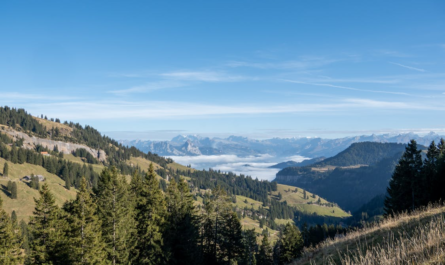Mount Rigi, often referred to as the Ruler of the Elevations is one of Switzerland’s most famous peaks. Situated in the heart of the Swiss Alps, it offers breathtaking views of Lake Lucerne and the surrounding valleys. However, beyond its scenic beauty, Mount Rigi holds historical significance as a pioneer in railway development. The construction of the Rigi Railway, the first mountain railway in Europe, marked a turning point in Swiss transportation, tourism, and engineering. This article explores the impact of Mount Rigi on Swiss railways, from its traditional beginnings to its modern advancements.
The Birth of the Rigi Railway: A Historical Milestone
Early Transportation Challenges
Before the introduction of railways, reaching the summit of Mount Rigi was an arduous journey. Travelers had to rely on mule paths, hiking trails, or sedan chairs carried by porters. These methods were time-consuming and accessible only to the physically fit and wealthy elite.
The Vision of Niklaus Riggenbach
Swiss engineer Niklaus Riggenbach saw an opportunity to revolutionize mountain travel. Inspired by the success of cogwheel railway systems in the United States, he designed a similar system to transport passengers up steep inclines. Riggenbach’s vision led to the creation of the Vitznau-Rigi Railway (VRB), which became Europe’s first cogwheel railway, inaugurated on May 21, 1871.
Technological Innovations
The Rigi Railway introduced a cogwheel mechanism that enabled trains to climb steep slopes safely. Unlike conventional railways, where friction alone propels the train, cogwheel systems use gears that mesh with a central rack, providing additional traction. This innovation set a precedent for future mountain railways, not only in Switzerland but worldwide.
Tourism and Economic Growth
Boosting Swiss Tourism
The completion of the Rigi Railway transformed Mount Rigi into a popular tourist destination. The ease of access attracted thousands of visitors annually, leading to the establishment of hotels, restaurants, and recreational facilities.
Influence on Swiss Tourism Industry
- Early Mass Tourism: The railway allowed ordinary citizens, not just the wealthy, to experience the beauty of the Swiss Alps.
- Development of Hotel Industry: Hotels such as Rigi Kulm Hotel became famous for offering breathtaking views and comfortable lodging.
- Artistic and Cultural Inspiration: Renowned artists like J.M.W. Turner and authors like Mark Twain visited and wrote about Mount Rigi, further enhancing its global appeal.
Expansion and Technological Advancements
Electrification and Modernization
By the early 20th century, steam-powered locomotives on the Rigi Railway were replaced with electric trains, making operations more efficient and environmentally friendly. The transition to electrification in 1937 reduced maintenance costs and improved service reliability.
Integration with the Swiss Railway Network
With advancements in railway infrastructure, the Rigi Railway was seamlessly connected to Switzerland’s expanding railway network. Travelers could now journey from major Swiss cities like Zurich and Lucerne to Mount Rigi with ease.
Safety and Engineering Improvements
- Automated Signaling Systems: Reduced the risk of accidents and improved coordination between trains.
- Modernized Train Designs: Enhanced passenger comfort and energy efficiency.
- Winter Operations: Introduction of snow removal technologies allowed year-round service, boosting winter tourism.
Influence on Other Swiss and Global Railways
Swiss Model for Mountain Railways
The success of the Rigi Railway inspired the construction of other cogwheel railways across Switzerland, including:
- Jungfrau Railway (1912): The highest railway station in Europe.
- Gornergrat Railway (1898): A scenic route offering views of the Matterhorn.
- Pilatus Railway (1889): The world’s steepest cogwheel railway.
Global Inspiration
- Japan’s Hakone Tozan Railway adopted Swiss cogwheel technology for its steep mountainous routes.
- Austria’s Schafberg Railway was influenced by Swiss mountain railway engineering.
- United States’ Pikes Peak Cog Railway incorporated Riggenbach’s rack-and-pinion system.
Environmental and Sustainability Considerations
Sustainable Tourism Practices
With increasing concerns about climate change and environmental sustainability, Mount Rigi’s railway system has adopted several eco-friendly practices:
- Electrification: Reducing carbon emissions compared to diesel or steam locomotives.
- Energy Recovery Systems: Modern trains convert braking energy back into electricity.
- Waste Management: Stations and trains promote recycling and waste reduction.
Preserving Natural Beauty
Despite the presence of a railway, Mount Rigi retains its pristine beauty through strict environmental regulations. The balance between infrastructure and nature conservation is a key priority for Swiss tourism authorities.
The Future of Mount Rigi’s Railways
Smart Rail Technologies
- Digital Ticketing and Automation: Enhancing passenger convenience.
- AI-Based Scheduling: Optimizing train schedules for efficiency.
- Hybrid and Hydrogen-Powered Trains: Potential future solutions to further reduce environmental impact.
Strengthening Cultural Heritage
Preserving the historical significance of the Rigi Railway remains a priority. Restoration projects ensure that vintage steam locomotives and historical train stations continue to educate visitors about the rich history of Swiss rail travel.
Mount Rigi’s railway is more than just a means of transportation; it represents Switzerland’s pioneering spirit in engineering, tourism, and environmental sustainability. From the groundbreaking innovations of the 19th century to the advanced technologies of the 21st century, the Rigi Railway has set a benchmark for mountain railways worldwide. As Switzerland continues to lead in railway advancements, Mount Rigi remains a symbol of the country’s rich heritage and commitment to modernity. Mount Rigi’s impact on Swiss railways extends far beyond its role as a scenic destination. The introduction of the Rigi Railway was not just an engineering feat; it was a revolutionary development that reshaped how people interacted with the mountains. Prior to the railway’s construction, the Swiss Alps were largely inaccessible to all but the wealthy elite and adventurous explorers. The establishment of the Vitznau-Rigi Railway in 1871 made the summit of Mount Rigi a reachable destination for a broader demographic, democratizing access to Switzerland’s mountainous beauty. This shift marked the beginning of mass tourism in Switzerland, which would grow exponentially throughout the 20th century. The presence of the railway fostered the growth of mountain hotels, spas, and the creation of recreational services, laying the foundation for the thriving tourism industry that Switzerland is known for today.
Moreover, the Rigi Railway’s introduction spurred innovation in the railway sector. It provided a practical model for other mountain railways worldwide. As the technology spread across Europe and beyond, it revolutionized mountain travel, demonstrating how railways could navigate steep terrain with efficiency and safety. The introduction of electric trains on the Rigi Railway in the 1930s further reflected the evolution of Switzerland’s commitment to sustainable transportation and technological excellence, offering a cleaner, more efficient alternative to steam-powered locomotives. These ongoing innovations continue to influence global railway systems today.
Mount Rigi’s railway is not merely a transportation system; it symbolizes Switzerland’s pioneering spirit in engineering, tourism, and sustainability. From the groundbreaking innovations of the 19th century to the modern advancements of today, the Rigi Railway has set a global benchmark for mountain railways. As Switzerland continues to lead in railway innovation, Mount Rigi stands as a testament to the country’s rich heritage and its commitment to modernity.



